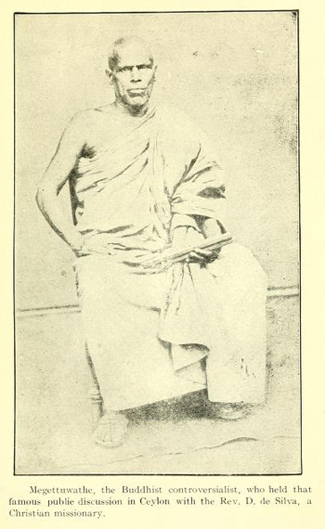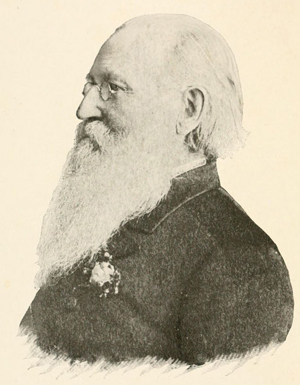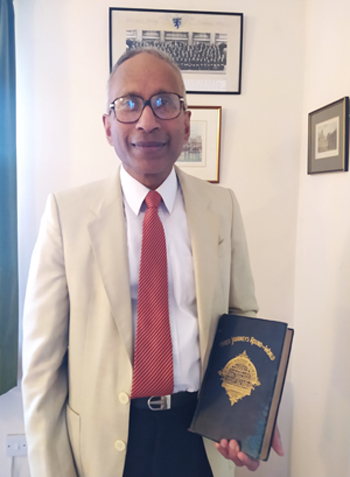A little known Englishman’s role in shaping Buddhist history

Rare picture : Ven. Migettuwatte Gunananda Thera of the Panadura Wadaya fame
It was something to write home about. Dr. Rohan Fernando, a scientist living in the UK, was pottering about as usual amongst old Ceylon books (his pet hobby being researching on colonial Ceylon) when a plate from a clothbound volume dumbfounded him.
It was a faded, 19th Century image, showing a Buddhist prelate seated outside a temple. With an ola leaf book in hand, he was poised almost impatiently, speaking of restless energy in his great frame and a rapier-sharp mind.
The caption simply said that this was “Megettuwathe, the Buddhist controversialist, who held that famous public discussion in Ceylon with the Rev. D. de Silva, a Christian missionary”.
Dr. Fernando realized that he had stumbled on probably the only extant photo in the world of the Ven. Migettuwatte Gunananda Thera, the ‘lion in the oratory’ who was the hero of the Panadura Wadaya of 1873, the great debate at Panadura when he singlehandedly defeated two Wesleyan missionaries with his skilful expounding of the Buddha’s teaching, thus putting an end to decades- if not centuries- of religious discrimination of Buddhists by certain missionaries.
The plate was found in a book by James Martin Peebles called ‘Five Journeys around the World’, an account of travels in the Pacific Islands, New Zealand, Australia, Ceylon, India and Egypt- a Victorian Cook’s tour with the whiff of many distant exotic places and people, not the kind of work which would pay homage to a serious Buddhist revivalist.
Peebles was no Captain Cook. A spiritualist and Theosophist, he was also a quack and inventor of a suspect concoction called Dr. Peebles’ Epilepsy Remedy. But by the time he first visited Ceylon in 1897, he had played a vital role in shaping the history of Buddhism here and abroad.

A world traveller: James Martin Peebles
It was Peebles who (ever the happy go lucky traveller) had while in India in the 1870s, picked up John Capper’s book on the Panaduraa Wadaya. Capper who edited The Ceylon Times – not known in the west at all- had written a book based on it which had somehow disseminated fast. The plume of smoke sent up by the Panaduraa Wadaya was thus spotted in America and Europe thanks to Peebles.
It was this book that was to lure Colonel Henry Steele Olcott, the greatest Buddhist revivalist in the island, into Buddhism and to Ceylon.
In ‘Five Journeys around the World’, Peebles spoke of influencing Olcott. He mused:
“Often do we write wiser than we know. No good thought dies — no truth perishes.”

Dr. Rohan Fernando with Peebles’ book, ‘Five Journeys around the World’
Quite inadvertently, Peebles, this mystic in his quest in the East, had served Ceylon in many ways. The photo of Ven. Gunananda newly discovered was obtained, says Dr. Fernando, probably when Peebles visited the Deepaduttaaramaya in Kotahena, Gunananda’s temple, during his first visit to Ceylon, in 1897.
In that visit he lingered awhile at the pulpit where the Ven. Gunananda had preached, the priest himself having passed away in 1890.
In ‘Five Journeys around the World’, Peebles dedicates two chapters to Ceylon- the lengthier first one to his maiden visit, and the second chapter to a shorter foray where he meets Orabi Pasha imprisoned in Kandy, and muses on Anuradhapura.
The yellowing pages of the copy that Dr. Fernando found gives an enticing account of Ceylon, given that Peebles, whatever his eccentricities, was a talented writer. He knew to balance a wry wit with neat observations, and evokes a Victorian Ceylon that was palmy, with jungles, ancient ruins and temples, “nearly extinct rock veddhas” who “ate bats, rats and lizards; roast wild pigs and monkeys”, tropical nights and devil dancers but also Colombo as a pleasant garden city and the great spiritual legacy of the island of which he is an authority.
Peebles rides on an elephant, visits the Aluvihara, and his records are so much more vivid and resonant than any fellow American visitor’s given his familiarity with the soul of the island. That he is not remembered here amongst people like Mrs. Higgins or Madame Blavatsky seems an unfair fluke of history.
| James Martin Peebles (1822-1922) | |
| Somewhat similar to Colonel Olcott in mien, Peebles was charismatic but a bit of a crank who was vehemently against tea and coffee apart from being a teetotaller and a vegetarian. His reply to the debate of which Oriental tea is best- “those of China or of Ceylon?” was “Take your choice, and tan your stomachs with theine! O ye tea- toper slaves of the nineteenth century!”He was interested in psychic healing, and regarded vaccination with the same abhorrence as vivisection, writing a treatise titled Vaccination a Curse and a Menace to Personal Liberty.The book he wrote on Panaduraa Wadaya was titled ‘Buddhism and Christianity Face to Face’, or ‘an Oral Discussion between the Rev. Migettuwatte, a Buddhist Priest, and Rev. D. Silva, an English Clergyman: Held at Pantura, Ceylon’, while his ‘How to Live a Century and Grow Old Gracefully’ was a bestseller. |


